Diese Nachricht wurde Ihnen von boesian via Google Reader gesendet.

In the final game of the match with classical time control, the opponents once again played the Rossolimo variation of the Sicilian Defence. Unlike the previous game when this system was used, the world champion managed to provide a surprise, sacrificing the pawn with e5 on the eighth move. Boris Gelfand thought long and hard before finding an interesting solution – on the tenth move he voluntarily returned the material and then sacrificed another pawn in order to reveal the position and activate his pieces. The challenger's decision proved to be justified as he was well compensated. Anand agreed that he was lacking the sufficient resources to fight for an advantage, eased the situation in the centre, and on the twenty-second move the opponents agreed to a draw.
Following the twelfth game, the score is equal at 6-6. According to the rules, the players must now play a tie-break: four games of rapid chess (25 minutes until the end plus 10 seconds per move). If they finish with a score of 2-2, a match of two blitz games will be played (5 minutes plus 3 seconds per move). If the score is still even, another match of two blitz games will be played (in total no more than 5 such matches). If the winner is not determined from these 10 games, the decisive Armageddon will be played.
The tie-break will be held on Wednesday, 30 May, at 12.00 pm.
The guests of honour on 28 May were the American art experts Bradley Bailey and Francis Naumann.
In the chess courtyard, grandmaster Sergey Karjakin played a game of multi-board chess with children. Sergey won nine victories, but one boy managed a draw in the game.

Official website: http://moscow2012.fide.com/en/
During the eleventh game of the match, just as in the ninth, Viswanathan Anand once again selected the Nimzo-Indian Defence for Black. Even during the early stages, the world champion surprised his opponent with the rare move of 8…Сd7, forcing the contender to think long and hard about his next move. The opponents traded queens rather quickly and moved on to the multi-piece endgame. Once again Boris Gelfand held the advantage of two bishops, however his so-called "hanging pawns" in the centre came under fire from enemy rooks. On the twentieth move, the Indian grandmaster launched tactical operations in the centre, preventing his opponent from stabilising the situation and strengthening his advantage. Running out of time to think, Gelfand decided to simplify things after which their positions were completely equalised. On the twenty-fourth move, the opponents agreed to a draw.
Following the eleventh game, the score is even at 5.5-5.5. Sunday, 27 May, is an off-day at the match. The twelfth and final game with classical time control will be held on Monday, 28 May. Viswanathan Anand will play with white. If the score is still even after this game, the world champion will be determined by a tie break (in games with accelerated time control) on Wednesday, 30 May.
The guests of honour on 26 May were the famous Russian musicians, pianist Nikolai Lugansky and cellist Alexander Knyazev.
Former world champion Vladimir Kramnik delivered a lecture to children and parents and also took numerous questions from the young audience.Similar to the fifth game, Viswanathan Anand started the tenth game with 1.e4. The opponents once again played the Sicilian Defence, but on the third move the world champion veered away from the Sveshnikov variation, choosing 3.Bb5. Just two moves later Boris Gelfand showed a new plan – 5…e5, which resulted in an interesting position with mutual chances. Judging by how quickly the moves were made, the Israeli grandmaster had analysed this variation very deeply. Soon the queens were exchanged, the position simplified considerably, but, according to many experts, all three results of the game were still possible. Black's position was weakened by doubled pawns on the queenside, but he had the two-bishop advantage. New exchanges followed, and the position simplified even further. On move 25 the opponents agreed to a draw.
The score is equal after 10 games – 5-5. Tomorrow, on 25 May, the opponents will have a rest day. The next game will be played on Saturday, 26 May. Gelfand will play White.
Today Edvard Radzinsky, the famous writer, historian and TV presenter, was the honorary guest of the match. The press conference was dedicated to the "Chess and Terror" theme. Radzinsky spoke about the unique chess set titled "Reformers Against Revolutioners", which was created in commemoration of the tragic events of the second half of the XIX century, when tsar Alexander II was murdered by members of the People's Freedom movement. Radzinsly dwelled not only on the chess set, which was a genuine masterpiece, but also on the controversial era in Russian history, when the government of Alexander II implemented radical reforms in the country's economic and political system.
Three simuls were played in the chess courtyard. The 12th World Champion Anatoly Karpov, the Champion of Europe 2011 Vladimir Potkin and Grandmaster Vladimir Belov played against children.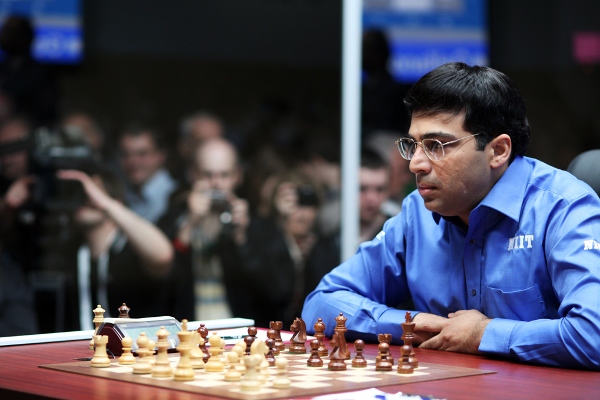


Official website: http://moscow2012.fide.com/en/
WORLD CHAMPION FOUND SHELTER IN A FORTRESS
The ninth game of the match for FIDE World Champion was played on 23 May at the State Tretyakov Gallery's Engineering Building
In the ninth game, Viswanathan Anand decided against the Slav Defence and played the Nimzo-Indian Defence with black. In response, Boris Gelfand selected the solid Rubinstein System. Following the opening, White acquired moveable pawns in the centre and an advantage of two bishops; at the same time the Black positions had no weaknesses. Soon the challenger had an opportunity to deal a blow to the centre with a move of 19.с5. As a result of this tactical operation, White won a queen for a rook, bishop and pawn. Experts believed that a draw was the most likely outcome, but White nevertheless still had a small chance for victory. Gelfand tried long and hard to undermine the black defence, although he may not have acted as accurately as he should have. White managed to open the kingside, however Anand successfully restructured his forces and with his concise play fought off all threats from his opponent after building a fortress. The opponents agreed to a draw on the forty-ninth move.
After the ninth game, the score is 4.5-4.5. The tenth game will be played today, 24 May. Viswanathan Anand will play with white.
A press conference was held on 23 May to mark the eightieth anniversary of the birth of artist Viktor Popkov, a brilliant master of the Soviet school of art. Popkov's painting The Team is Resting became the artistic symbol of the 2012 World Chess Championship Match. The press conference was attended by Pyotr Kozorezenko, a doctor of art studies and the author of a book about Popkov, as well as Russian Art magazine editor Inna Pulikova.
Also on this day, the match was attended by Natan Sharansky, a well-known Israeli politician, social activist and writer. Sharansky gave interviews to several television channels and also played an unplanned simultaneous chess display with children in the Chess Corner.

Official website: http://moscow2012.fide.com/en/
Anand equalises the score
The eighth game of the match began exactly like the third one, which was the only game where Boris Gelfand was on the verge of defeat but still managed to survive.There's no surprise that as soon as on move 3 Black moved away from the previous games. A pawn structure appeared on the board that is typical of Saemisch system of the King's Indian, but there was a significant difference in the position of the pieces: both white knights were on the queenside. Trying to use this circumstance, Black decided to go for complications on the kingside, thus provoking Viswanathan Anand to push forward the g-pawn, which would weaken his king's position. The world champion picked up the gauntlet and sharp play started where the opponents had to calculate a great number of lines. Gelfand miscalculated one of them: as he admitted, when making his move 14…Qf6, he hadn't noticed the reply 17.Qf2!, after which Black's position immediately became hopeless. Since he failed to find a defence against large material losses or a mate attack, the challenger resigned.
Anand regained the balance: after 8 games the score is 4-4. Tomorrow, on 22 May, the opponents have a rest day. The ninth game will be played on Wednesday, 23 May. Gelfand will play White.
On 21 May Grandmaster Ian Nepomniachtchi, the Champion of Europe 2010, was the honorary guest. Grandmasters Alexander Grischuk and Alexander Motylev played a simul against children in the chess courtyard.


Official website: http://moscow2012.fide.com/en/
Boris Gelfand: "I believe that, not only in chess, but in life in general, people place too much stock in ratings"
During the press conference, Boris Gelfand said that he strayed away from the continuation that we had seen in the first and third games at move number six, by choosing to play 6. Qc2, a move that he had previously used in practice. Black had an isolated pawn in the centre, but the Champion decided to sacrifice it and castled short on the fourteenth move (14…0-0. Novelty). The Israeli grandmaster refused to say if he had been surprised by Anand's play. "After the 17th move, it became clear that black had a strong shape. White could not bring its pieces out and therefore had to give up a pawn," the challenger summed up. He further noted that only home analysis would show whether he could have tried to save the pawn and play for something more. Both competitors agreed that, despite the material balance that had been restored, white nevertheless continued to apply pressure as its pieces were in more active positions. But black was able to neutralise this threat with a series of precise moves. Viswanathan Anand was happy with the moves 20…Qe6, 21…f6, 22…Qc6, after which black was able to simplify the game and move into a drawing endgame.
After discussing the game, journalists moved on to other questions. It turns out that the players and their teams have been able to keep up with the latest football news. Anand said that his seconds would probably be going for Bayern, while Gelfand wasn't even sure if he would watch the match, as Barcelona, his favourite team, would not be playing.
When asked which of the Tretyakov's paintings they would like to see in their own homes, the World Champion expressed his affinity for Shishkin's Morning in a Pine Forest and Vasnetsov's Bogatyrs (or Three heroes), while Gelfand chose the paintings of Aivazovsky. At the same time, both players noted that they have absolutely no talent for art and recalled that once, at the opening of a tournament in Monaco, they were asked to showcase their creative prowess in painting. Neither was happy with their attempts, although both were very lauding at the press conference of Vassily Ivanchuk and Loek van Wely, who also took part.
Boris Gelfand commented on Garry Kasparov's statement that "the uniqueness of this match lies in the fact that, for the first time in the modern history of the game, the World Championship Match will not decide who the strongest player in the world is."
"Clearly, Garry wants to remind those who have forgotten that he was once the strongest chess player in the world. I believe that, not only in chess, but in life in general, people place too much stock in ratings – they pay attention to which TV shows have the highest ratings, how many friends they have on Facebook, and it's funny. The best shows often have low ratings and it is impossible to have thousands of real friends." For his part, the World Champion said that he tries not to pay attention to such comments and only focuses his thoughts exclusively on what is going on in the match.
Official website: http://moscow2012.fide.com/en/
The Slav Defence did not let Anand down
In the sixth game, the opponents once again played the Slav Defence. This time the challenger opted for the variation 6.Qc2 instead of 6.b3. The game developed further on quietly: Black got an isolated pawn in the centre, but it was compensated for by a somewhat passive position of the white pieces. Soon the d5-pawn was exchanged and the position simplified. By move 25 each side had a rook and a bishop of the same colour remaining on the board. The resulting endgame was estimated as drawn and four moves later the contenders agreed to a draw. The match score is equal: 3-3. Tomorrow, on 19 May, the opponents have a rest day. The seventh game will be played on Sunday, 20 May. Boris Gelfand will play White.
Today Garry Kasparov, the 13th world champion, was the honoured guest at the match. At the press conference, Garry readily answered many questions from the journalists in great detail. Then he joined first the English-speaking commentators, Dirk Jan ten Geuzendam and Peter Svilder, and after that the Russian-speaking commentators, Ilya Smirin and Alexander Grischuk, and took part in analyzing the game. Later Kasparov went down to the chess courtyard where he played a simul against young talented Russian chess players.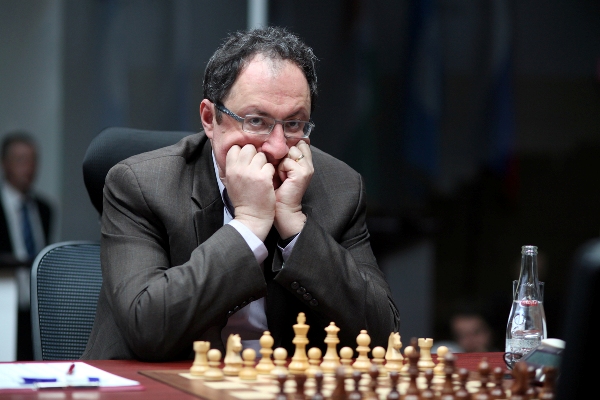
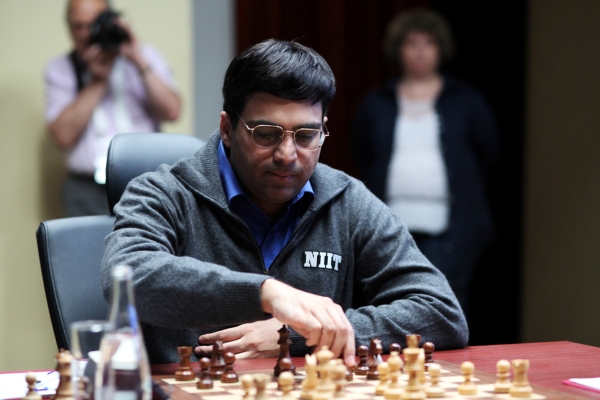
Official website: http://moscow2012.fide.com/en/
The move 1.e4 is no surprise for Gelfand
In the fifth game of the match the World Champion changed the opening and played 1.e4. The challenger was ready for such a development and immediately played 1…c5. The Chelyabinsk Variation of the Sicilian Defence was played out very quickly. On the 20th move, a technical position with bishops of opposite colours appeared on the board, and as soon as the 26th move was played, the opponents agreed to a draw. The match score is equal – 2.5-2.5. Tomorrow, on the 18 May, the sixth game of the match will be played with Boris Gelfand having the white colour.
Official website: http://moscow2012.fide.com/en/
Armour is so far stronger than weapons
The opponents continued their Slav Defence duel that started in the second game of the match. White was the first to deviate from the previous game and managed to get the so-called two-bishop advantage in the middlegame. After a series of exchanges, the game transformed into an ending with somewhat better chances for White. In the resulting technical position, the game could have had either of two results: a draw or a victory for White. It turned out, however, that the white pieces were not sufficiently well coordinated and that the bishop's advantage over the knight was not enough for a win: with precise play, Viswanathan Anand built a "fortress" and deflected all threats. A draw on the 34th move.
During the press conference, Boris Gelfand noted that there were no critical moments in the game as such, but the question was whether White would manage to gain an advantage or Black would find a clear way to equalise. "Even though I got the two-bishop advantage, the coordination between the pieces was not very good, so Black did not have any major problems." The opponents considered the possibility of going into a knight against bishop endgame after 32. Rc6, but concluded that the white king lacked the tempo to occupy square d4, so White's chances in this variation were also minimal.
The challenger showed the position after 18…h6, which produced a great aesthetic impression on him. At that moment, each square on the d-file was occupied by black and white pieces, Black's rooks were on squares c8 and e8, and the whole array resembled a T-shaped figure that is rarely seen on a chessboard.
Assessing the situation in the match after the first four games, the world champion said the match was just developing and the rivals were still trying each other out. "You don't really want to start doing evaluations, but so far it's a pretty tough match," commented Viswanathan Anand. Boris Gelfand refused to give any assessment of individual parts of the match and stressed that any analysis was pointless until after the 12th game.
Asked by a journalist what scenario the players would have preferred during the game and if something had gone wrong at some point, Gelfand answered jokingly: "Well, of course I would have loved my opponent to choose some doubtful variation that I know well. Then I would have used a strong novelty and won the game, say, by the 20th move. I would be too naïve to count on that, however, so of course one has to be ready for any course of events." The match score is equal: 2-2. May 16 is a rest day for the opponents, with the fifth game to be played out on 17 May. The world champion will play with white pieces.
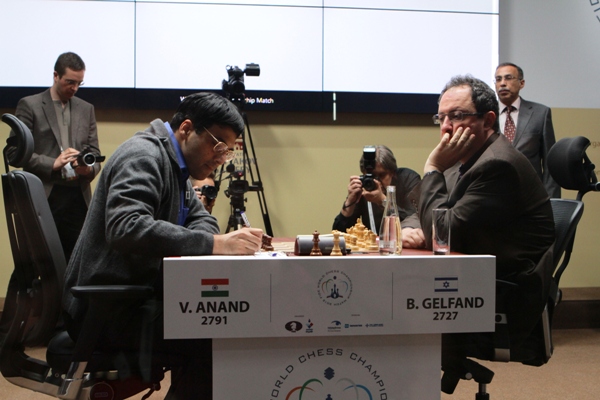
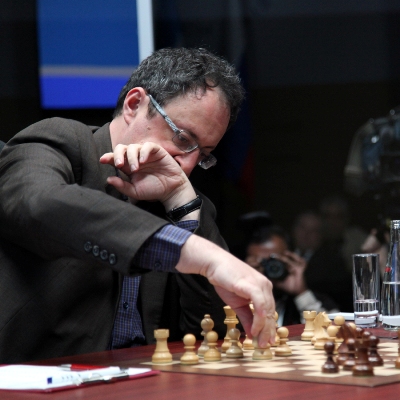
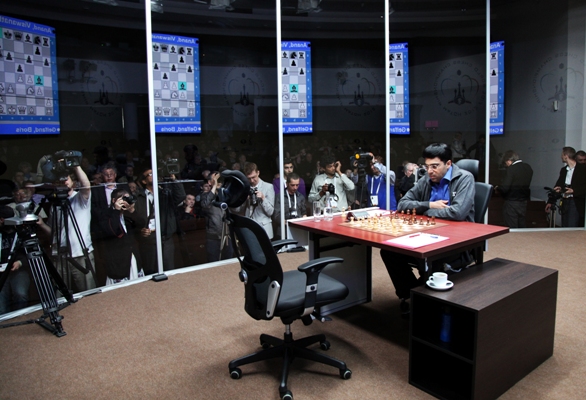
Official website: http://moscow2012.fide.com/en/
Perpetual check saves the challenger
In the 14th move Boris Gelfand sacrificed a pawn in order to mobilise his pieces. Viswanathan Anand managed to rebuff all his opponent's threats with some precise moves and got some serious chances to win. In the 32nd move the chess players moved to a heavy piece ending in which White's extra passed pawn was very dangerous. However, in the 34th–35th moves the World Champion played inaccurately, after which both of Black's rooks penetrated into the opponent's rear, and Gelfand declared a perpetual check. A draw on the 37th move. The score for the match is level – 1.5-1.5. The fourth game in the match will be played tomorrow, 15 May.
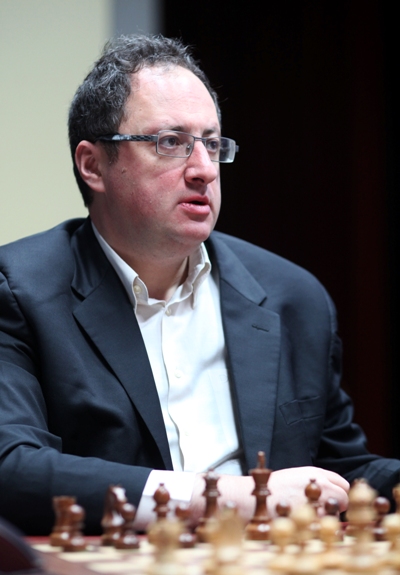
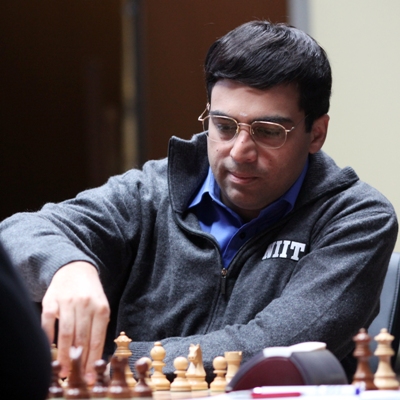
Official website: http://moscow2012.fide.com/en/
Photo Gallery of the 3rd Round
THE SECOND GAME OF THE FIDE WORLD CHESS CHAMPIONSHIP IS DRAWN
The second game of the FIDE World Chess Championship Match was played on 12 May in the Engineering Building of the State Tretyakov Gallery.
Today the rivals did not bring any big surprises to each other, having played a relatively new, but a very solid variation of the Slav Defence. After Black's 14th move Boris Gelfand thought for a long time and finally chose a line which led to an endgame with a slight edge for White. According to Gelfand, a seemingly sharper continuation 15. Bg5 would actually have resulted in an equal position. At the end of the game a few precise moves helped Viswanathan Anand to get sufficient counterplay. On the 25th move the challenger offered a draw, which the champion accepted. The match score is equal - 1:1. Tomorrow is the rest day. The next game will be played on 14 May.
The FIDE World Chess Championship Match between World Champion, Viswanathan Anand (India), and challenger, Boris Gelfand (Israel), is taking place from 10 till 31 May 2012 in the Engineering Building of the State Tretyakov Gallery. The organisers of the match are FIDE (the World Chess Federation) and the RCF (the Russian Chess Federation). The initiator and sponsor of the match in Moscow is the Russian entrepreneur Andrey Filatov (co-owner of N-Trans Group). Other sponsors of the competition are businessman Guennadi Timtchenko, as well as the Ladoga charity foundation, NVision Group the company Novatek and Academician A.A. Raspletin Almaz-Antei OJSC SHDB.
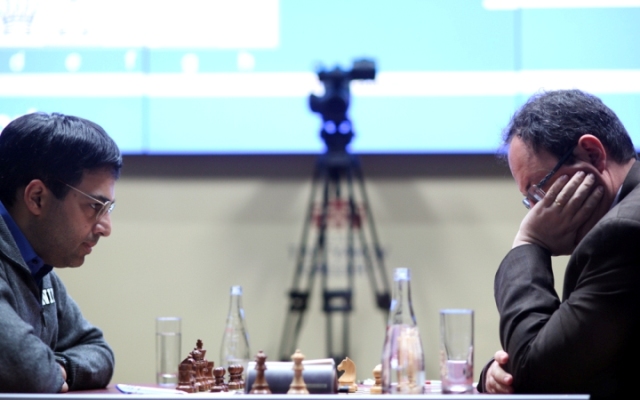
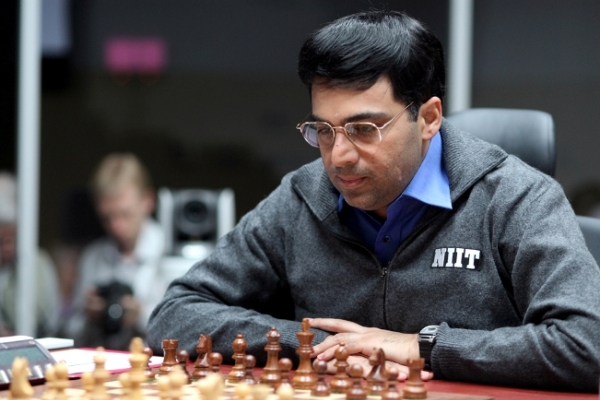
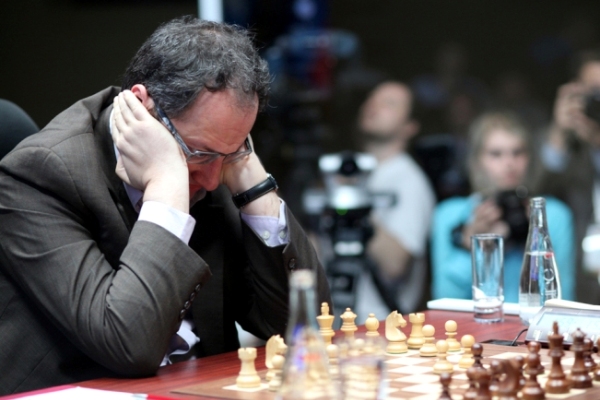
Official website: http://moscow2012.fide.com/en/
THE FIRST GAME OF THE FIDE WORLD CHESS CHAMPIONSHIP IS DRAWN
The first game of the FIDE World Chess Championship Match was played on 11 May in the Engineering Building of the State Tretyakov Gallery.
The World Champion played white. The two contenders immediately engage in open combat. Boris Gelfand chose an opening that was unusual for him, while Viswanathan Anand responded with surprise after surprise, playing a fairly rare but subtle variation. The challenger reacted in the most radical way: he took a flank pawn, thus subjecting his king, which remained in the centre, to a certain risk. Black rebuffed all threats with precise play and forced a transition to an ending that was somewhat better for itself. However, the assessment of the position did not depart much from parity, and literally within a few moves the contenders agreed to a draw.
At the press conference Boris Gelfand attributed his decision to the fact that he could not see any specific ways for Black to fight for an advantage. So the challenger, who has successfully entered the game and will play white six times during the rest eleven games, is retaining a certain moral advantage.
The video from the players' press conference is available at the match official web site - http://moscow2012.fide.com/en/
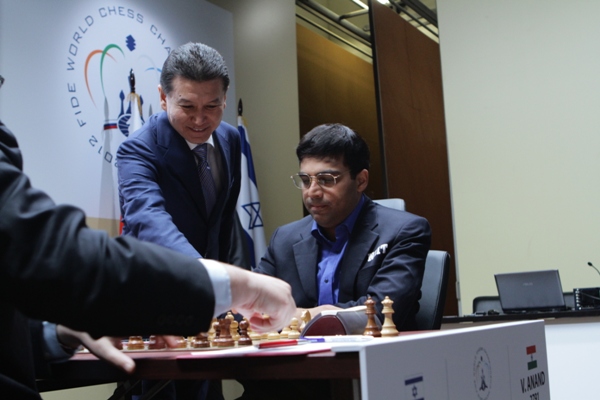
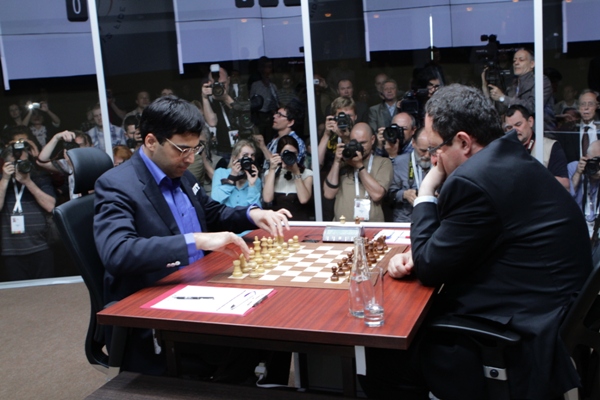
On the 10th of May the opening ceremony of the World Chess Championship Match took place in Mikhail Vrubel Hall of the Tretyakov State Gallery. Mr. Kirsan Ilyumzhinov, FIDE President, Mr. Arkady Dvorkovich, Chairman of Supervisory Council of RCF and Ms. Irina Lebedeva, General Director of the State Tretyakov Gallery welcomed the participants and guests. Also present were Mikhail Gorbachev, the 1st President of USSR, Aleksandr Zhukov, Chairman of Russian Olympic Committee and the 12th World Chess Champion Anatoly Karpov.
The drawing lots procedure was conducted by the Chief Arbiter Ashot Vardapetyan in an original style, underlining an indissoluble connection between chess and the world culture. The easels with "paintings", diagrams of the previously played games by Anand and Gelfand in the 90s, were set up on the stage. One diagram showed the victory of the current World Champion, another one of the challenger. Two wooden boxes with brushes and paint inside were prepared for the Grand Masters. The right to choose was given to Anand as to the World Champion. Both players stepped to their own diagrams, dipped brushes in the paint and left their autographs on the "paintings". At that moment the spectators could see that Anand signed with white paint and Gelfand with black one. So, in the first game the current World Champion will play white pieces.
The opening ceremony was preceded by a press-conference. The Grand Masters revealed who will be their seconds. Peter-Heine Nielsen, Rustam Kasimdzhanov, Radoslaw Wojtaszek, and Surya Ganguly will help Anand. Aleksandr Khuzman, Maxim Rodstein and Pavel Eljanov will help Gelfand.
Opening Ceremony Photo Gallery
Press-conference Photo Gallery
The first game of the match will begin at 3.00pm on 11 May. Full schedule on the official website.
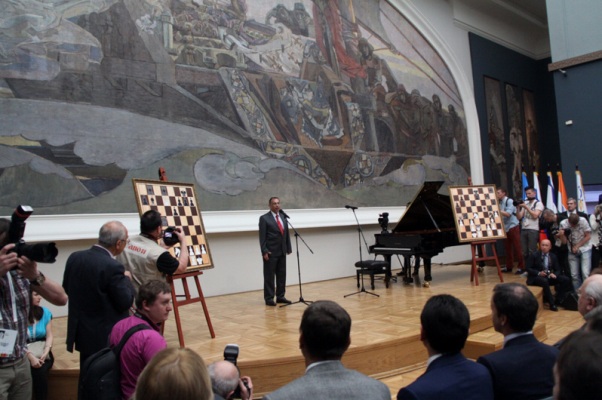
Drawing of lots procedure
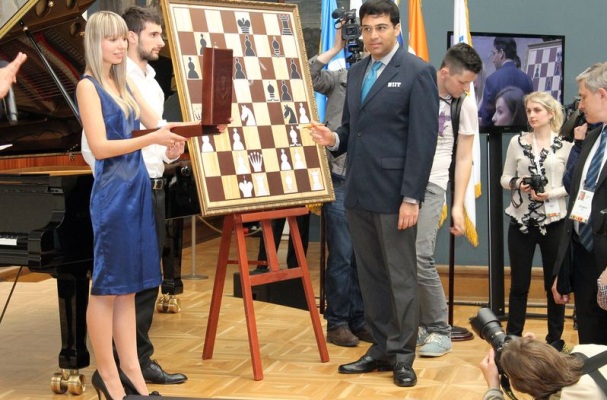
Anand left white autograph on his "painting"
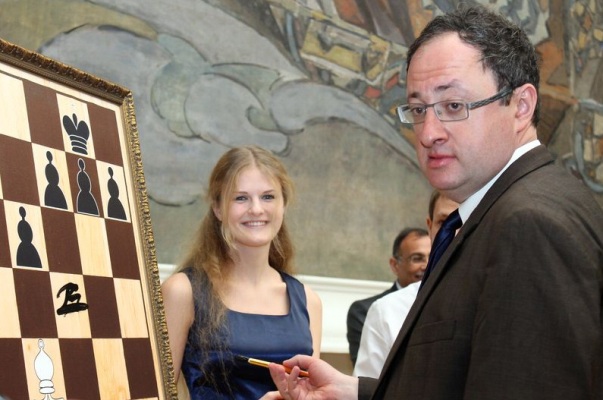
And Gelfand left black autograph on his "painting"


Press-conference
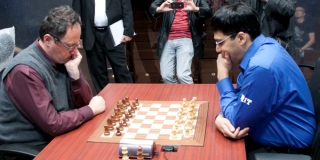
Viswanathan Anand and Boris Gelfand inspect match venue
In accordance with the match regulations for the chess crown, the World Champion and the Challenger for the title conducted an inspection of the match hall in the Engineering Building of the State Tretyakov Gallery.
The ceremony was attended by Chairman of the Management Board of the Russian Chess Federation Ilya Levitov, Chief arbiter Ashot Vardapetyan, Match supervisor FIDE Deputy President Georgios Makropoulos, Appeals Committee Chairman Kurt Jungwirth, FIDE Vice President Israel Gelfer, Assistant to the FIDE President Berik Balgabaev and Chairman of the Israeli Chess Federation Moshe Slav.
Both chess players were satisfied with the match venue and organisation. After inspecting the match area, Viswanathan Anand and Boris Gelfand gave an interview to channel "Russia-24".
Optionen:
- Abonnieren von World Chess Federation - FIDE mit Google Reader
- Erste Schritte mit Google Reader – Immer informiert über die für Sie wichtigsten Websites


(1)(7).jpg)
(1)(6).jpg)
























